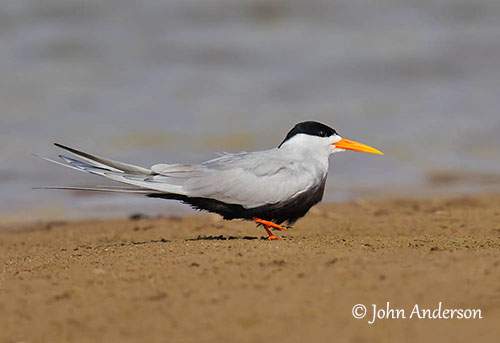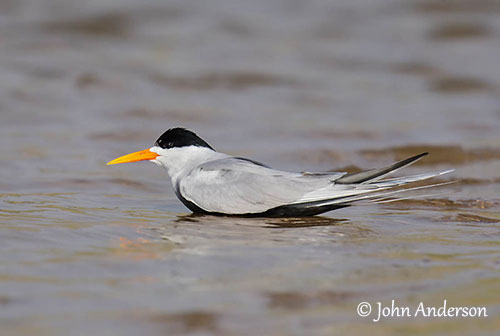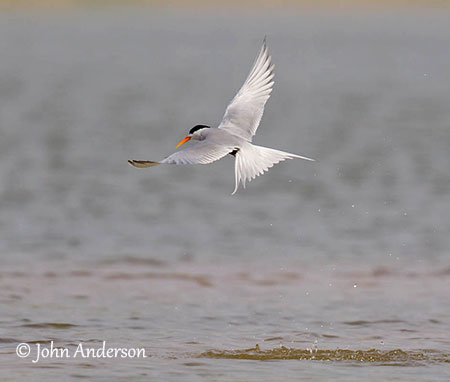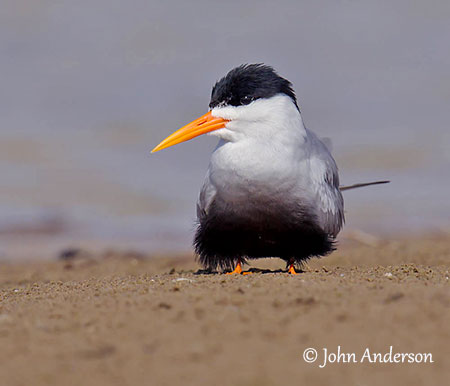
PROTECTION / THREATS / STATUS:
The Black-bellied Tern is heavily threatened by the destruction of the habitat, especially the breeding areas, for agriculture expansion. The eggs are collected for food, the nests are flooded (caused by dams) and overfishing is also a problem. Disturbance and over-harvesting of wetland products are increasing.
River damming, predation and egg collection are the main causes of the disappearance of this tern from Cambodia. In India, this species is also affected by water extraction, sand and gravel extraction, predation by cats and dogs, but also by House Crow, and pollution from both industry and agriculture.
The population is roughly estimated at 6,700/17,000 mature individuals and it is suspected to be declining rapidly, despite the large range and several protected areas.
The Black-bellied Tern is almost extinct in most part of the range, and the species is currently listed as Endangered.
Fr: Sterne à ventre noir
Ang: Black-bellied Tern
All: Schwarzbauch-Seeschwalbe
Esp: Charrán Ventrinegro
Ita: Sterna pancianera
Nd: Zwartbuikstern
Sd: svartbukig tärna
Photographer:
John Anderson
John Anderson Photo Galleries
Text by Nicole Bouglouan
Sources:
HANDBOOK OF THE BIRDS OF THE WORLD Vol 3 by Josep del Hoyo-Andrew Elliott-Jordi Sargatal - Lynx Edicions - ISBN: 8487334202
OISEAUX DE MER – Guide d’identification de Peter Harrison – Editions Broquet (Canada) – ISBN-10 : 2890004090 – ISBN-13 : 978-2890004092
Wikipedia, the free encyclopaedia
Indian Birds - Black-bellied Tern
Endangered Black bellied Tern Sterna acuticauda Gray 1832 in Odisha needs conservation attention
National Mission for Clean Ganga
Breeding reports and conservation implications of the Endangered Black-bellied Tern
Cheemablog - Black-bellied Tern... Endangered...
Black-bellied Tern
Sterna acuticauda
Charadriiformes Order – Laridae Family
INTRODUCTION:
This large tern is found in the Indian subcontinent, with a range extending from Pakistan, Nepal and India to Myanmar. The Black-bellied Tern occurs near lowland rivers and lakes up to 700 metres of elevation.
Very agile in flight, it performs plunge-diving for fish, but also catches insects on the wing. In addition, it also skims over water surface like skimmer species. Fish, crustaceans and both aquatic and terrestrial insects are the main part of the diet.
The Black-bellied Tern is territorial and monogamous. It does not breed colonially like most Laridae species, but it may sometimes nests near other seabirds. The nest is on the sand, on sand spits or sandy islands in rivers.
This species is almost extinct in most of range where it is threatened by destruction of the breeding habitat, egg-collection, overfishing and flooding of nest, disturbances and river damming.
The Black-bellied Tern is currently listed as Endangered.
DESCRIPTION OF THE BIRD:
Biometrics:
Length: 32-35 cm
The Black-bellied Tern in breeding plumage has pale grey upperparts including the long, pointed wings. The tail is pale grey with longer, white outermost rectrices.
On the underparts, the throat is white. The pale grey breast shades into the brownish-black belly and undertail-coverts. The underwing is white with a darker band across the secondaries.
On the head, forehead, crown and nape are black, whereas the rest of the head is white.
The long, pointed bill is bright orange-yellow. The eyes are very dark to black. Legs and webbed feet are reddish orange.
Male and female are similar.

The adult in non-breeding plumage has whitish belly with black mottling. The long outer rectrices are absent. On the head, the forecrown is white with black streaks. There is a black band behind the eye. The bill has black tip.
The juvenile shows some red at base of mandibles and the feet are blackish.
RANGE:
The Black-bellied Tern occurs in Pakistan (R Indus) and near the major river systems of India, E to C Bangladesh and Assam valley.
This species is rare in S China, Nepal and Myanmar. It is probably extinct in NW Thailand, Laos, Cambodia and S Vietnam.
HABITAT:
The Black-bellied Tern usually frequents wetlands, freshwater lakes, rivers, streams, and occasionally ditches and pools. It can be seen from lowlands to 700 metres of elevation depending on the range.
This species is an inland bird and does not occur on the coast. It breeds on sand spits and sandy islands in rivers.
CALLS AND SONGS: SOUNDS BY XENO-CANTO
The Black-bellied Tern utters a clear piping “peuo”, but we can also hear a kind of barking of slightly variable pitch “nyap” or “nyark”. These calls are regularly given, sometimes in shorts series of 3-4 notes/second.

BEHAVIOUR IN THE WILD:
The Black-bellied Tern feeds mainly on invertebrates. Its diet includes both aquatic and terrestrial insects, crustaceans, tadpoles and fish.
The aquatic prey are taken with an oblique plunge-dive into the water. It also picks up insects by skimming over the water surface and the ground like the species of genus Rynchops. It may occasionally feed in flocks.
The Black-bellied Tern is not a colonial breeder, although it may occasionally breed with other seabirds such as skimmers, practincoles and River Terns. The nest-site is often on sand spits or sandy islands in rivers.
The Black-bellied Tern is resident. The juveniles may disperse after the breeding season, with some local movements related to food availability.
The flight is slow and involves a lot of flapping, in spite of the long wings. However, this tern is very agile when foraging and fishing.

REPRODUCTION OF THIS SPECIES:
The breeding season occurs between February and May.
The Black-bellied Tern sometimes breeds with other aquatic bird species, but it is not a colonial breeder. The nests are widely spaced, more than 1 km, but this species is primarily solitary nester.
It is territorial and monogamous. The nest is on the ground, in open site near river or lake, usually sand spits or islands in rivers. The nest is a shallow depression in the bare sand, usually more than 200 metres from the water. But the nests are sometimes flooded when the water levels are changing, due to river damming.
The female lays 2-3 greyish-olive eggs with scattered dark markings, making them almost invisible on the sand. Incubation and fledging periods are unknown.
The nest is usually placed in sunny area, and the adults shade eggs and chicks. They also sprinkle water from their belly feathers. Both parents defend the nest by mobbing intruders and predators.
